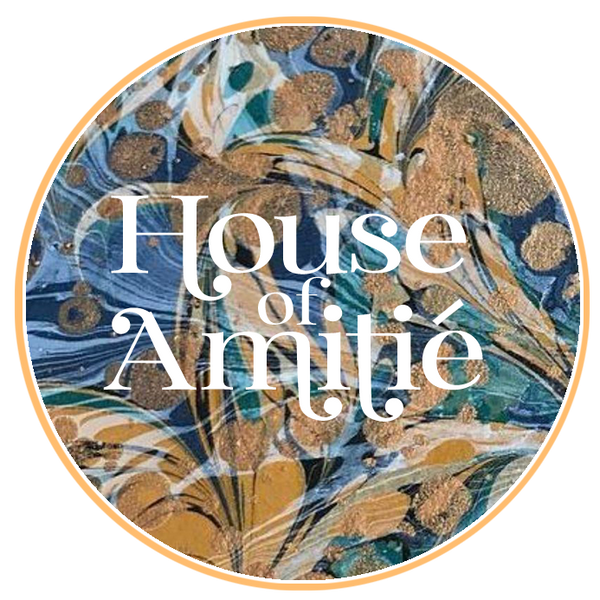The Art of Marbling
The origins of marbling and the patterns that form our first House of Amitié collection.

The earliest form of marbling was called ‘Suminagashi’ and originated in Japan in the 12th century. Translated it means ‘floating ink’.
To create these House of Amitié designs we need a base liquid which is far more gelatinous than water, so we add a powder derived from an Irish Moss called Carrageen.
This viscous surface allows us to flick on colourful droplets of watercolour gouache and as they gently expand and float, we can tease them into a variety of patterns and designs using a series of tools ranging from a simple stylus to complex handmade combs consisting of fine metal teeth.
Once the desired pattern is achieved we lay down a sheet of paper which has been pre-treated by the marbler with a mordant, which crucially allows the paint to stick to the surface of the paper.
A light rinse prior to hanging to dry completes the cycle and the next day the papers are ready to be used.
Historically marbled papers were most frequently used by bookbinders, gracing the insides and outer covers of beautifully bound leather books.
Today marbled papers are still regularly used by bookbinders but in addition they have been used in a myriad of other ways from restoration projects, bespoke packaging, haute couture and of course within interiors, which is where House of Amitié enters the room.
At House of Amitié the specially designed marbled patterns have been created using centuries old techniques and the history, heritage and timelessness of this craft remains a fundamental part of our brand and we wish to honour this magical art and let the designs be enjoyed by everyone.
Below we describe a little more about how this wonderful craft translates into our printed wallpapers and fabrics.



Below explains a little more about the history of some the patterns that form this collection and how they've been created:
'Flourish'
Part of our Heritage collection
Flourish is loosely based on the historic ‘Snail’ or ‘Curl’ marble pattern, which was first created in France in the mid 17th Century. Traditionally this design would have been made to a palette of several colours and a ‘comb’ consisting of many pins would have been used to create a uniform curl across the sheet. At House of Amitié, we've modernised this pattern by creating it in 3 separate mono palettes for a minimal and fresh take on this timeless design. In addition a chunky stylus (similar to a dowelling rod or thick knitting needle) has been used to draw random swirls into the paint to provide more energy and flow to the design.
'Moucheté'
Part of our Heritage collection
Our classic Moucheté pattern is based on the traditional Italian or ‘Vein’ marble. Moucheté is an alternative name for this pattern and also translates to 'dappled' or 'mottled' which we think is quite an apt description for the most minimalist of our inaugural designs. This style of marbling was created in Italy at the end of the 18thCentury. Using a simple palette we have simplified this design relevant for the present day whilst retaining a look reminiscent of marbled stone - perfect for a period home. To add an extra dimension to our Moucheté wallpapers, this design has been given a Mica finish on a fiberous substrate base, to provide a beautiful iridescent and textural finish.
'Serpentine'
Part of our Heritage Collection
Our Serpentine pattern is based on perhaps one of the most iconic and recognisable marbled designs, most often referred to as being a ‘Peacock’ or ‘Bouquet pattern’. Originally first created at the end of the 19th century this design is created by using a series of combs to form the highly intricate and decorative pattern. We have modernised this well-known marbled design by incorporating a rich palette and enlarging the scale. Our 'Summer' colour-way has also been finished on a Mica Fiberous Substrate to give a luxe sheen and textural look against the rich summer palette.
'Juniper'
Part of our Avant-Garde Collection
Juniper, as its name suggests, is inspired by nature and botanicals and brings a floral impression that is not generally associated with marbling. Juniper was created using a fine stylus - with the flicks and feather like shapes being the antitheses to stricter combed marbled designs. Juniper is full of expression with the rich inky blue & multi colour palette adding impact to any room. This was House of Amitié's first ever design and what began the 2023 collection!
'Ditzy'
Part of our Avant-Garde Collection.
Ditzy is our second design within our Avant-garde collection. As its name suggests, Ditzy is a smaller scale pattern with a speckled appearance. This unique effect has been created by adding elements to the paint which in turn creates an almost textured appearance that's very detailed the closer you look! Working with tones of the same colour, this pattern combines the traditional art form of marbling with the experimental.
Our Flourish pattern in 'Willow' during our initial design trial process


Please take a look at the video below to see some traditional paper marbling, or hold your phone camera over the QR code to see a little glimpse of where the magic happens

